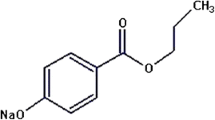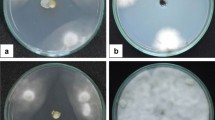Abstract
Pre- and post-infection activities of phosphonate and fungicides (azoxystrobin, chlorothalonil, cyazofamid, copper hydroxide, and copper sulfate) against white powdery rot on fig leaves caused by Phytophthora palmivora were determined. Phosphonate and fungicides were applied at 3, 7, or 14 days before inoculation and 16, 24, or 40 h after inoculation. Phosphonate and four fungicides (except for chlorothalonil) had protectant activity for up to 14 days before inoculation. Protectant activity between phosphonate and the four fungicides did not differ significantly. These fungicides did not have a curative activity, whereas only phosphonate had a curative activity when applied 16 h after inoculation. The pre-infection activity of phosphonate was determined in fig fields. Phosphonate provided excellent protectant activity, and its activity did not differ significantly from that of the copper fungicides. The activity of phosphonate in the life cycle of P. palmivora was compared with that of the five fungicides. Half-maximal effective concentration of the inhibition of mycelial growth was low for phosphonate, chlorothalonil, and the two copper fungicides. Mycelial growth was least affected by azoxystrobin and cyazofamid, but n-propyl gallate, an alternative oxidase inhibitor, in combination with these fungicides, significantly inhibited mycelial growth. Sporangium formation was sensitive to all compounds. Germination of encysted zoospores was sensitive to azoxystrobin, cyazofamid, and chlorothalonil and least sensitive to phosphonate and the two copper fungicides. The activity of phosphonate on mycelial growth and sporulation of P. palmivora suggests it has potential for controlling the disease.

Similar content being viewed by others
References
Afek U, Sztejnberg A (1989) Effects of fosetyl-Al and phosphorous acid on scoparone, a phytoalexin associated with resistance of citrus to Phytophthora citrophthora. Phytopathology 79:736–739
Cohen Y, Coffey MD (1986) Systemic fungicides and the control of oomycetes. Annu Rev Phytopathol 24:311–338
De Waard MA, Georgopoulos SG, Hollomon DW, Ishii H, Leroux P, Ragsdale NN, Schwinn FJ (1993) Chemical control of plant diseases: problems and prospects. Annu Rev Phytopathol 31:403–421
DerSimonian R, Kacker R (2007) Random-effects model for meta-analysis of clinical trials: an update. Contemp Clin Trials 28:105–114
DerSimonian R, Laird N (1986) Meta-analysis in clinical trials. Control Clin Trials 7:177–188
El-Gholl NE, Alfieri SA Jr (1984) Fruit rot of fig caused by Phytophthora palmivora. Proc Fla State Hort Soc 97:327–328
Erwin DC, Ribeiro OK (1996) Phytophthora diseases worldwide. APS Press, St. Paul
Esser L, Quinn B, Li Y-F, Zhang M, Elberry M, Yu L, Yu C-A, Xia D (2004) Crystallographic studies of quinol oxidation site inhibitors: a modified classification of inhibitors for the cytochrome bc 1 complex. J Mol Biol 341:281–302
Farih A, Tsao PH, Menge JA (1981) Fungitoxic activity of efosite aluminum on growth, sporulation, and germination of Phytophthora parasitica and P. citrophthora. Phytopathology 71:934–936
Fenn ME, Coffey MD (1984) Studies on the in vitro and in vivo antifungal activity of fosetyl-Al and phosphorous acid. Phytopathology 74:606–611
Fenn ME, Coffey MD (1989) Quantification of phosphonate and ethyl phosphonate in tobacco and tomato tissues and significance for the mode of action of two phosphonate fungicides. Phytopathology 79:76–82
Guest DI, Bompeix G (1990) The complex mode of action of phosphonates. Australas Plant Pathol 19:113–115
Hori S (1915) Phytophthora fici. J Plant Prot 2:930–932 (in Japanese)
Kanda Y (2013) Investigation of the freely available easy-to-use software ‘EZR’ for medical statistics. Bone Marrow Transplant 48:452–458
Ko WH, Chase LL, Kunimoto RK (1973) A microsyringe method for determining concentration of fungal propagules. Phytopathology 63:1206–1207
Kromann P, Pérez WG, Taipe A, Schulte-Geldermann E, Sharma BP, Andrade-Piedra JL, Forbes GA (2012) Use of phosphonate to manage foliar potato late blight in developing countries. Plant Dis 96:1008–1015
Matheron ME, Porchas M (2000) Impact of azoxystrobin, dimethomorph, fluazinam, fosetyl-Al, and metalaxyl on growth, sporulation, and zoospore cyst germination of three Phytophthora spp. Plant Dis 84:454–458
Mitani S, Araki S, Yamaguchi T, Takii Y, Ohshima T, Matsuo N (2001a) Antifungal activity of the novel fungicide cyazofamid against Phytophthora infestans and other plant pathogenic fungi in vitro. Pestic Biochem Physiol 70:92–99
Mitani S, Araki S, Takii Y, Ohshima T, Matsuo N, Miyoshi H (2001b) The biochemical mode of action of the novel selective fungicide cyazofamid: specific inhibition of mitochondrial complex III in Phythium spinosum. Pestic Biochem Physiol 71:107–115
Miyake N, Ito S (2005) Seasonal occurrence of fruit rots of fig fields (in Japanese). Annu Rep Kansai Plant Protect Soc 47:87–89
Miyake N, Nagai H, Kato S, Matsusaki M, Ishikawa H, Kageyama K (2015) Detection of damping-off of Cape gooseberry caused by Pythium aphanidermatum and its suppression with phosphonate. J Gen Plant Pathol 81:192–200
Mondal SN, Vicent A, Reis RF, Timmer LW (2007) Efficacy of pre- and postinoculation application of fungicides to expanding young citrus leaves for control of melanose, scab, and Alternaria brown spot. Plant Dis 91:1600–1606
Rebollar-Alviter A, Madden LV, Ellis MA (2007) Pre- and post-infection activity of azoxystrobin, pyraclostrobin, mefenoxam, and phosphite against leather rot of strawberry, caused by Phytophthora cactorum. Plant Dis 91:559–564
Rosenberg MS, Garrett KA, Su Z, Bowden RL (2004) Meta-analysis in plant pathology: synthesizing research results. Phytopathology 94:1013–1017
Smillie R, Grant BR, Guest D (1989) The mode of action of phosphite: evidence for both direct and indirect modes of action on three Phytophthora spp. in plants. Phytopathology 79:921–926
Ypema HL, Gold RE (1999) Kresoxim-methyl: modification of a naturally occurring compound to produce a new fungicide. Plant Dis 83:4–19
Zhang C, Zhang W, Ma HQ, Zhang GZ (2013) First report of Phytophthora palmivora causing fruit rot of fig (Ficus carica L.) in China. Plant Dis 97:1252
Ziogas BN, Baldwin BC, Young JE (1997) Alternative respiration: a biochemical mechanism of resistance to azoxystrobin (ICIA 5504) in Septoria tritici. Pest Manag Sci 50:28–34
Author information
Authors and Affiliations
Corresponding author
Rights and permissions
About this article
Cite this article
Miyake, N., Nagai, H. Efficacy of phosphonate in controlling white powdery rot of fig caused by Phytophthora palmivora . J Gen Plant Pathol 83, 390–397 (2017). https://doi.org/10.1007/s10327-017-0746-3
Received:
Accepted:
Published:
Issue Date:
DOI: https://doi.org/10.1007/s10327-017-0746-3




